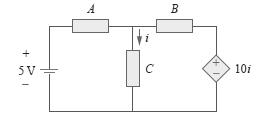Active Elements (Energy Sources)
There are 2 types of elements found in electrical circuits: Active and Passive Elements
Active Elements (Energy Sources)
The energy sources which are having the capacity of generating the energy are called active elements. The most important active elements are voltage or current sources that generally deliver power/energy to the circuit connected to them.
There are two kinds of sources
- Independent sources
- Dependent sources
Independent Sources
An ideal independent source is an active element that provides a specified voltage or current that is completely independent of other circuit elements.
Independent Sources
An ideal independent voltage source is an active element that gives a constant voltage across its terminals irrespective of the current drawn through its terminals. In other words, an ideal independent voltage source delivers to the circuit whatever current is necessary to maintain its terminal voltage. The symbol of idea independent voltage source and its V-I characteristics are shown in Fig. A.

Fig. A – Ideal Independent Voltage Source
Practical Independent Voltage Source:
Practically, every voltage source has some series resistance across its terminals known as internal resistance, and is represented by Rse. For ideal voltage source Rse = 0. But in practical voltage source Rse is not zero but may have small value. Because of this Rse voltage across the terminals decreases with increase in current as shown in Fig. B
Terminal voltage of practical voltage source is given by
VL= VS – IL Rse

Fig. B – Practical Independent Voltage Source
Ideal Independent Current Source
An ideal independent Current source is an active element that gives a constant current through its terminals irrespective of the voltage appearing across its terminals. That is, the current source delivers to the circuit whatever voltage is necessary to maintain the designated current. The symbol of idea independent current source and its V-I characteristics are shown in Fig. C.

Fig. C – Ideal Independent Current Source
Practical Independent Current Source:
Practically, every current source has some parallel/shunt resistance across its terminals known as internal resistance, and is represented by Rsh. For ideal current source Rsh = ∞ (infinity). But in practical voltage source Rsh is not infinity but may have a large value. Because of this Rsh current through the terminals slightly decreases with increase in voltage across its terminals as shown in Fig. D.
Terminal current of practical current source is given by
IL = Is -Ish

Fig. D – Practical Independent Current Source
Dependent (Controlled) Sources
An ideal dependent (or controlled) source is an active element in which the source quantity is controlled by another voltage or current.
Dependent sources are usually designated by diamond-shaped symbols, as shown in Fig. E. Since the control of the dependent source is achieved by a voltage or current of some other element in the circuit, and the source can be voltage or current, it follows that there are four possible types of dependent sources, namely:
(a) A voltage-controlled voltage source (VCVS)
(b) A current-controlled voltage source (CCVS)
(c) A voltage-controlled current source (VCCS)
(d) A current-controlled current source (CCCS)

Fig. E – Symbols for Dependent voltage source and Dependent current source
Dependent sources are useful in modeling elements such as transistors, operational amplifiers, and integrated circuits. An example of a current-controlled voltage source is shown on the right-hand side of Fig. F, where the voltage 10i of the voltage source depends on the current i through element C. Students might be surprised that the value of the dependent voltage source is 10i V (and not 10i A) because it is a voltage source. The key idea to keep in mind is that a voltage source comes with polarities (+ -) in its symbol, while a current source comes with an arrow, irrespective of what it depends on.

Fig. F – The source in right hand side is current-controlled voltage source

